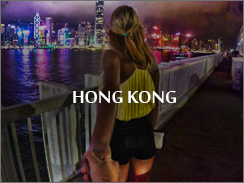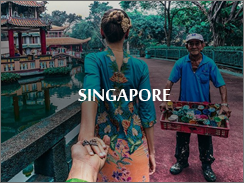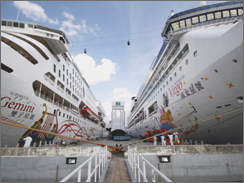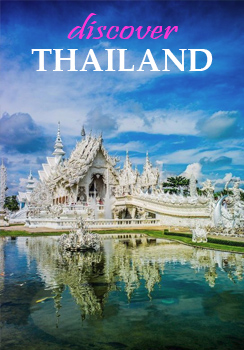Malaysia: Southeast Asia's Next Great Foodie Destination

Malaysian food mixes in so many cultures—Arabic, Chinese, Thai, Indian, and more—that you could never appreciate them all in one sitting. So bring your appetite.
British, Dutch, Portuguese, Thai, Indian, Javanese, Arabic, Chinese, Sumatran. Is it any wonder that Malaysian chefs produce some of the most hard-to-resist meals on the planet? Just look at all the cultures thrown into their proverbial pot. Within the country, the culinary landscape changes dramatically from one region to the next, which is why any traveler worth her salted duck egg won't want to stop at just one. To take in the full scope of Malaysian flavors, it's essential to explore (at least) these three top towns.
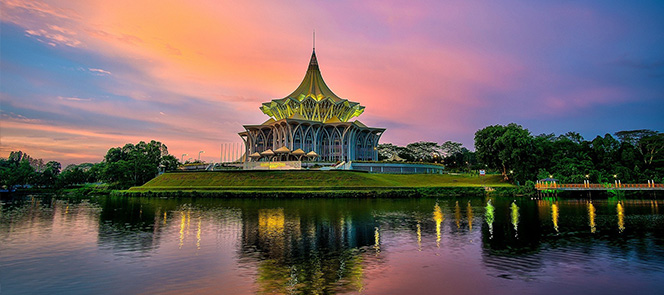
1. KUALA LUMPUR
THE COSMOPOLITAN CAPITAL
"We are a country of eaters—food is everything," says 36-year-old Kuala Lumpur resident Sherena Razaly, as she sips spiced tea at the Vishal Curry House in Brickfields, an Indian neighborhood near the capital's main train station (19 Jalan Travers, 011-60/3-2274-6819, chicken biryani $3). She should know: Razaly runs one of the city's most popular Malay restaurants, Enak KL. On her days off, Razaly rotates among her favorite local lunch spots to join the folks on the customer side of the counter. At Vishal, her companions include office workers in collared shirts and bindi-dotted women in saris, and they fill nearly every seat around the restaurant's long, shared tables (181 Jalan Bukit Bintang, enakkl.com, beef rendang $9).
They've come here for banana leaf, an assortment of curries, stewed and pickled vegetables, and rice eaten (without utensils) off a ridged banana leaf the size of a skateboard. Some dishes, such as chicken biryani (a drumstick and a hard-boiled egg hidden beneath a pile of rice that's infused with cinnamon, cloves, and saffron), arrive in a silver bowl—diners just dump the contents onto a leaf and dig in. For those still perfecting their technique, a server stands by with a broom.
Like much of Malaysia's best food, banana leaf is tied to the past: It arrived with South Indian immigrants who came to work on 19th- century British rubber plantations. Today, the descendants of those families make up about a tenth of the country; Malaysians of Chinese descent (or Straits Chinese) account for close to a quarter. Ethnic Malays such as Razaly, most of whom are Muslim, make up about half of the population. Each group has its own time-tested culinary traditions and brings its own recipes to the national table.
The ethnic Malay approach to cooking blends Chinese, Indian, Indonesian, and Arabic elements, and is the backbone of the menu at Razaly's restaurant, a 15-minute taxi ride away from the train station. KL, as the city is commonly called, is known as much for its die-hard retail hounds as for its passionate foodies. Enak straddles both worlds. The restaurant is set inside the upscale Starhill Gallery shopping center, but it provides a homegrown contrast to its slick neighbors, Vuitton and Valentino. The dining room is decorated with floral batik wall hangings, and the menu showcases recipes, such as the beef rendang and botok-botok (mackerel steamed in papaya, laksa, and other leaves), that have been passed down in the family for generations. Razaly's mother even makes periodic visits to inspect the chefs' work.
Such family-operated passion projects help anchor the city in both past and present. Take Yut Kee: One of KL's last kopitiam, or coffeehouses, it was established in 1928 by a Hainanese immigrant who still watches over the place, albeit from a faded portrait. Tucked away in a row of well-aged shop houses, Yut Kee now shares the neighborhood with skyscrapers but retains its traditional feel, thanks to the efforts of third-generation owner Mervyn Lee. At lunchtime, the place throbs. Crowds jam the sidewalk, and waiters swirl among the marble-topped tables, delivering deep-fried Hainanese pork chops and plates of Yut Kee's specialty roti babi, a thick, pan-fried pocket of bread stuffed with braised pork, crabmeat, Chinese sausage, water chestnuts, and onions. "It's our secret family recipe," Lee says. "We're the only ones in KL who make it." Another not-so-secret component of Malaysian cuisine is Worcestershire sauce, a leftover from the British colonial era. Embraced by local chefs and used liberally as a condiment for all kinds of dishes, it imparts an Asia-meets-Europe flavor unlike anything else on earth (35 Jalan Dang Wangi, 011-60/3-2698-8108, roti babi $2.75).
A 10-minute walk from Starhill, the 18-room Anggun Boutique Hotel provides guests with a glimpse into a bygone lifestyle. The hotel is housed in a pair of adjoined residences that served as a family retreat for a clan of early 20th-century Chinese immigrants, and it still has a few period details, such as lanterns from the 1920s and a check-in desk built from salvaged hardwood railway sleepers (7-9 Tengkat Tong Shin, anggunkl.com, doubles from $92).
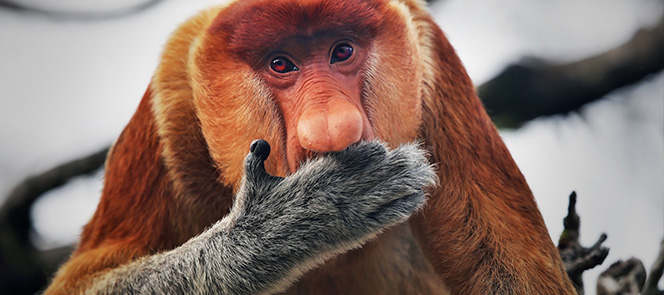
2. MALACCA
THE COLONIAL TIME CAPSULE
Compared with fast-paced Kuala Lumpur, Malacca, a three-hour bus ride south, might as well be cast in resin. Malaysia's oldest city was once the region's top commercial maritime post, which explains the ruined 500-year-old Portuguese fort and 18th-century Dutch Protestant church. The town's true legacy, though, is not its supply of postcard-ready relics, but its recipes. This is where Malaysia's fusion cuisine all began.
One of Malacca's most popular and eclectic attractions is the half-mile-long Jonker Street, a row of antiques and souvenir shops that transforms into the city's main night market on weekends. Jonker 88, a kitschy café decorated with tattered Chinese lanterns and framed photos of Bruce Lee, caters to the daytime crowd. It's most famous for its cendol, an unbelievable Southeast Asian twist on a snow cone: Vendors fill a bowl with short, fat, pea-flour noodles and kidney beans, followed by a mound of shaved ice and a ladle full of gula Malacca, the town's namesake dark, smoky, palm-sugar syrup. The sweet snack will sustain you through a long stroll along the neighborhood's dreamy, lamp-lit canals (88 Jalan Hang Jebat, jonker88.com, cendol $1.25).
It's not uncommon to find restaurants around town that have been perfecting their recipes since—well, forever. At Capitol Satay, the kitchen has produced the same addictive peanut-sauce fondue steamboat for 55 years. Patrons select from skewers loaded with more than 80 different foods (chicken, beef, crab-stuffed tofu, fish wontons, okra) then dip them into buckets filled with boiling satay (a peanut-based dip) at each table. A side of soft bread cubes is always on hand to mop up the fragrant sauce. Be warned: You will stuff yourself silly here. In fact, there's a "wall of champions" at the back of the restaurant displaying laminated photos of patrons labeled with names, dates, and the number of sticks eaten. If you beat the record—currently at 201—you eat for free. "Next time," third-generation owner Low Yong Cheng offers, "don't eat breakfast. Don't eat lunch. Just come here." Noted. (41 Lorong Bukit Cina, 011-60/6-283-5508, skewers 25¢)
Travelers who want a deeper sense of Malaccan culture can find it at the Baba Nyonya Heritage Museum, a 115-year-old former residence of a Peranakan, or Straits Chinese, family. (Baba refers to the area's 15th- and 16th-century Chinese settlers; nyonya the Malay women they married.) Their offspring, many of whom were part of the wealthy merchant class, decorated their homes lavishly with embroidered silk wall hangings and woodwork carved by Chinese masters; examples of both are lovingly preserved in the museum (48-50 Jalan Tun Tan Cheng Lock, 011-60/6-283-1273, entry $3.25).
Local chefs apply that same spare-no-expense attention to every detail of their food. A short walk from the museum, you'll find Donald & Lily's, a simple café built in the back of the family's home. The house Nyonya laksa combines fresh coconut-milk soup, gumball-size fish balls, and pillowy tofu squares, all topped with shredded egg and cucumber and a dollop of chile paste. Producing the labor-intensive dish begins with a daily grind: Lily prepares the herbs by hand with a mortar and pestle every morning. "A real Nyonya laksa will never have anything from a package or a can," Lily says—and she's not afraid to back it up. Her daughter, Jenny, has been known to give kitchen tours to their more inquisitive patrons (behind 31 Jalan Tun Tan Cheng Lock, 011-60/6-284-8907, Nyonya laksa $1.25).
Malacca's famous fusion applies to many of the locales, too. Built in a century-old home in the city's historic district, several of the 14 rooms at the Courtyard @ Heeren hotel have handmade colonial-era tiles or four-poster beds, and they're all equipped with rainfall showers and Wi-Fi (91 Jalan Tun Tan Cheng Lock, courtyardatheeren.com, doubles from $66).
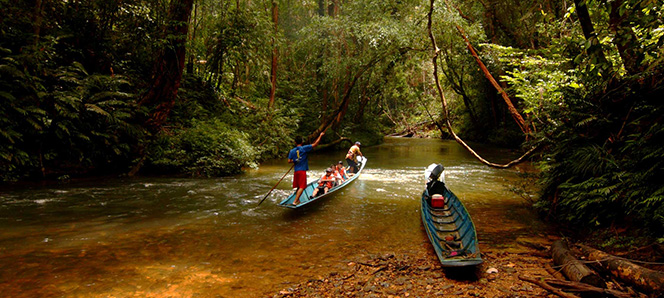
3. PENANG
HAWKER-FOOD CENTRAL
If KL is all urban rush and Malacca is frozen-in-time ambience, Penang is understated and slightly frayed. The capital, George Town, is a jumble of quiet streets lined by crumbling, pastel-hued houses with distinctive arched doorways. (UNESCO granted George Town and Malacca World Heritage status in 2008 for their architecture.) You could spend days wandering George Town's narrow alleys and incense-filled temples or months eating your way through the city's hawker centers—casual, open-air complexes filled with vendors of cheap, local meals starting at about $1 per dish.
There are dozens of these places spread around town, so finding an expert guide—of either the human or digital variety—is a must. Each center has its own operating hours and signature dishes, but they all share a common protocol: Customers place orders at individual stalls, wait for the food to be brought to their tables, and pay when it arrives. A new, free Penang Street Food app (for iPad and iPhone) launched by the local tourism board describes 12 essential dishes and narrows down the best vendors to a mere 38. For more targeted advice, Rasa Malaysia, a company run by Bee Yin Low, the author of a top Malaysian food blog, can set travelers up with private tours ( penangculinarytour.com, half-day culinary tour $66; full-day $115). Rasa Malaysia's guides often begin outings with a spin through the bustling morning Chowrasta Market, a fixture since 1890. Its paths take in glistening piles of fish, towers of tomatoes and red chiles, trays of colorful kuih (sweet rice cakes), and suspended cuts of grilled meat. Vendors are happy to chat up curious travelers—and to hand out samples of pork jerky or five-spice pork rolls (Penang Rd., pork jerky $10.50 per pound).
Six blocks away, the Street of Harmony underscores the diversity seen throughout the country: An Anglican church, a Buddhist temple, a Hindu shrine, and a mosque all share the same short stretch of road. The street also cuts through the center of Penang's Little India, where Bollywood tunes blare from doorways and outdoor stalls dispense Indian sweets and a drink called teh tarik. The name, meaning "pulled tea," refers to the age-old technique used to create its signature frothiness: Pour condensed milk and hot black tea back and forth between two cups, holding one high above the other.
There's plenty to see in George Town itself, but if you venture farther out, you'll find more to explore, particularly in the city's outlying hawker centers. Bee Hooi, 15 minutes away by car, is known for its oh chien (oyster omelet), hokkien mee (egg and rice noodles in a prawn-and-pork broth, topped with water spinach, boiled eggs, sliced pork, prawns, fried shallots, and chile paste), and char kway teow (wok-fried rice noodles with garlic, prawns, Chinese sausage, and cockles). (Corner of Jalan Burmah and Lorong Pulau Tikus, char kway teow from $1.15)
After the chaos of the hawker centers, retreating to a well-designed hotel is a welcome reprieve. The 10-room, Australian-run Straits Collection is a boutique hotel built in a handful of converted shop houses in the historic quarter. It has an on-site library as well as a restaurant/cinema, Kopi Cine, that screens movies every night at 8:30. The guest rooms are decorated with antique wardrobes, stained glass, and well-chosen vintage prints of Penang cityscapes. It's the quintessential balance of luxury and scruffiness that's so typical of this global crossroads of culture—and taste ( 47-55 Stewart Ln. and 89-95 Armenian St., straitscollection.com.my, doubles from $138).


